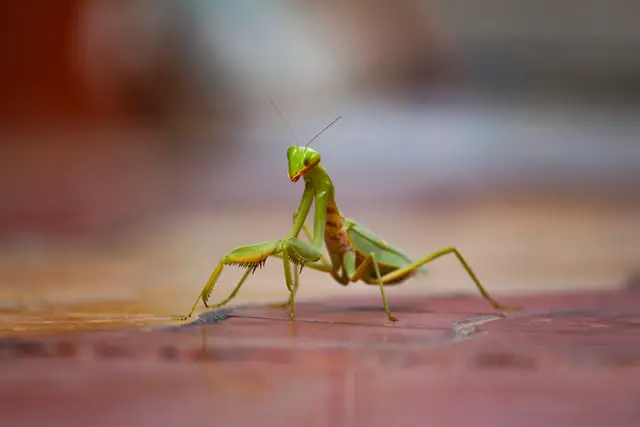If you’ve ever encountered a praying mantis, you know just how fascinating and peculiar these insects can be. With their unique appearance and behavior, it’s no wonder that people often wonder if they pose a threat to our furry friends. In this article, we’ll explore the relationship between praying mantises and dogs, debunking some common misconceptions along the way.
Praying Mantis Behavior and Features
Praying mantises are carnivorous insects that resemble fierce-looking miniature humans. They have powerful jaws that snap together to devour their prey, and some species can even jump quickly to catch their target. Female praying mantises have a leafy-looking appendage on their abdomen for laying eggs and two spikes to impale their prey while eating. These insects also possess the ability to flip their bodies upright while stepping on prey. Some species may emit a strong odor or defend themselves by kicking if they feel threatened.
Praying Mantises and Dogs: The Truth Unveiled
Let’s address the burning question: are praying mantises dangerous to dogs? The answer is no, they are not extremely dangerous to dogs. However, it is important to be cautious if your dog encounters one while out and about. Dogs may be curious and try to eat the mantis, which could cause them minor distress. While praying mantises themselves do not transmit diseases, they can be considered nuisance insects as they tend to congregate around lights and invade homes at night.
Benefits of Praying Mantises
Despite their somewhat intimidating appearance, praying mantises are actually beneficial insects. They play a vital role in controlling harmful bug populations such as mosquitoes, flies, and even black widow spiders. For insect enthusiasts, observing these creatures can be an interesting and educational experience.
Praying Mantis Bites: An Unpleasant Experience
Although praying mantises are generally harmless, they do possess a toxin that can cause pain and nausea when threatened. However, their bite is not strong enough to cause significant harm to dogs. Their jaws are not as powerful as those of other insects like bees or hornets. In most cases, a bite from a praying mantis will not break the skin and will only cause minor discomfort. It is worth noting that some dogs may be hypersensitive to the toxin and may react adversely if bitten by a large number of mantises. Therefore, it is always best to keep dogs away from plants that tend to attract these insects.
Frequently Asked Questions
Are praying mantises poisonous?
While praying mantises are generally not poisonous, certain species within the Mantodea order may have toxins or venom that could be potentially harmful to humans and dogs. It’s important to exercise caution and avoid mishandling these insects to prevent any venomous bites.
Is it dangerous if a dog eats a praying mantis?
Most dogs will not have any problems if they consume an adult praying mantis. However, some dogs with sensitive stomachs or allergies could have an adverse reaction. Praying mantises are also excellent swimmers and will only risk being consumed by a dog if they are in an isolated body of water or within close proximity to it.
How to keep your dog away from a praying mantis?
If you find that your dog is drawn to praying mantises, there are a few strategies you can try. Some pet owners have found success by spraying their dogs with water using a squirt bottle or by using peanut butter or an old sock stuffed with a paper towel to mimic the presence of a snake or other threat.
How painful is the bite of a praying mantis?
While the bite of a praying mantis can be painful, it is not as painful as that of many other insects. The potent toxin in the mantis stinger may cause a burning sensation in humans, along with milder symptoms such as swelling.
What is the lifespan of a praying mantis?
The lifespan of a praying mantis varies depending on the species. The average lifespan of a female mantis in the wild is about two years, but some can live up to five years. In captivity, males have been known to live for as long as 20 years, while some wild individuals have been reported to live over 30 years.
How to treat your dog if bitten by a praying mantis?
If your dog is bitten by a praying mantis, start by cleaning the wound with soap and water. Crush an aspirin and apply it to the affected area for relief from any pain. If you are allergic to aspirin, use an EpiPen instead. It is important to seek veterinary assistance within an hour of the bite to ensure proper care for your dog.
Conclusion
Praying mantises may be intriguing creatures with their unique appearance and behavior, but they pose little threat to our canine companions. Understanding their behavior and potential risks can help us better protect our dogs while appreciating the benefits that these insects bring to our ecosystem. So, next time you come across a praying mantis, take a moment to observe and appreciate their fascinating presence, knowing that they are not a significant danger to your beloved furry friend.
For more information about caring for your pets, visit Pawsoha.
